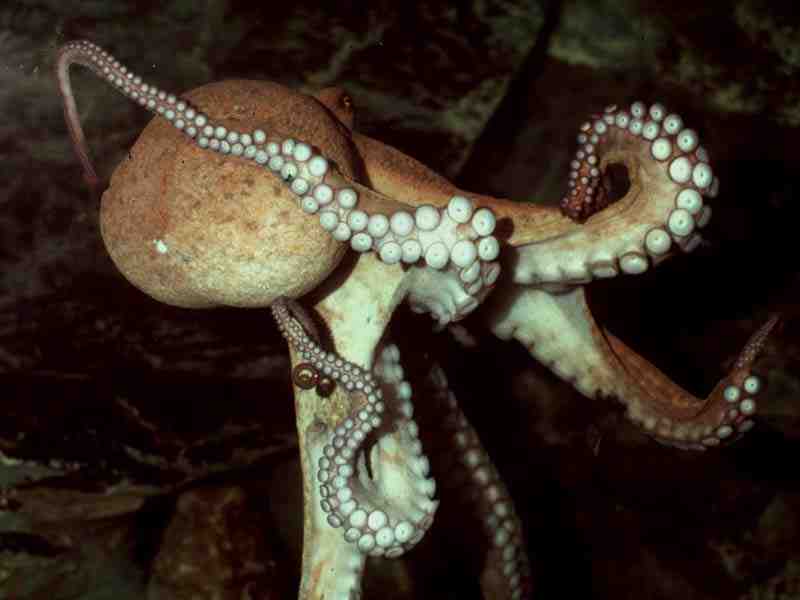Common octopus (Octopus vulgaris)
Distribution data supplied by the Ocean Biodiversity Information System (OBIS). To interrogate UK data visit the NBN Atlas.Map Help
| Researched by | Emily Wilson | Refereed by | Admin |
| Authority | Cuvier, 1797 | ||
| Other common names | - | Synonyms | - |
Summary
Description
The arms are thick and stout bearing two rows of longitudinal suckers.
The colour varies from grey-yellow-brown-green and can change according to the situation.
Recorded distribution in Britain and Ireland
Reaches its north-eastern limit in south-western Britain and the western English Channel.Global distribution
Worldwide in temperate and tropical waters.Habitat
Found on rocky coasts, shallow sublittoral. Has adapted to live in very different habitatsDepth range
0-200mIdentifying features
- Medium to large sized, body distinctly warty.
- Arms stout of about equal length and thickness with two longitudinal rows of suckers, dorsal pair of arms slightly shorter.
- Colour - variable, grey-yellow-brown-green according to situation.
Additional information
No text enteredListed by
- none -
Bibliography
Boyle, P.R. (ed.), 1983. Cephalopod Life Cycles, vol 1. Species Accounts. London: Academic Press Inc. (London) Ltd.
Campbell, A., 1994. Seashores and shallow seas of Britain and Europe. London: Hamlyn.
Guary, Jean-Claude & Fowler, Scott W., 1982. Experimental studies on the biokinetics of plutonium and americium in the Cephalopod Octopus vulgaris Marine Ecology Progress Series, 7, 327-335.
Hanlon, R. T. & Messenger, J. B., 1996. Cephalopod Behaviour. Cambridge: Cambridge University Press.
Hayward, P., Nelson-Smith, T. & Shields, C. 1996. Collins pocket guide. Sea shore of Britain and northern Europe. London: HarperCollins.
Howson, C.M. & Picton, B.E., 1997. The species directory of the marine fauna and flora of the British Isles and surrounding seas. Belfast: Ulster Museum. [Ulster Museum publication, no. 276.]
ICES, 1994. Report of the study group on the life history assessment of Cephalopods. Copenhagen-Denmark ICES, K:7, 32.
Miramand, P. & Bentley, D., 1992. Concentration and distribution of heavy metals in tissues of two cephalopods, Eledone cirrhosa and Sepia officinalis, from the French coast of the English Channel. Marine Biology, 114, 407-414.
Nixon, M. & Mangold, K., 1996. The early life of Octopus vulgaris (Cephalopoda: Octopodidae) in the plankton and at settlement: a change in lifestyle Journal of the Zoological Society of London, 239, 301-327.
Roper, C.F.E., Sweeney, M.J. & Nauen, C.E., 1984. FAO species catalogue. Vol. 3. Cephalopods of the world. An annotated and illustrated catalogue of species of interest to fisheries. FAO Fisheries Synopsis, 125, 3, 277. Avaliable: http://www.fao.org/docrep/009/ac479e/ac479e00.htm
Villanueva, R., 1995. Experimental rearing and growth of planktonic Octopus vulgaris from hatching to settlement Canadian Journal of Fisheries and Aquatic Sciences, 52, 2639-2650.
Datasets
Conchological Society of Great Britain & Ireland, 2018. Mollusc (marine) data for Great Britain and Ireland - restricted access. Occurrence dataset: https://doi.org/10.15468/4bsawx accessed via GBIF.org on 2018-09-25.
Conchological Society of Great Britain & Ireland, 2023. Mollusc (marine) records for Great Britain and Ireland. Occurrence dataset: https://doi.org/10.15468/aurwcz accessed via GBIF.org on 2024-09-27.
Environmental Records Information Centre North East, 2018. ERIC NE Combined dataset to 2017. Occurrence dataset: http://www.ericnortheast.org.ukl accessed via NBNAtlas.org on 2018-09-38
Lancashire Environment Record Network, 2018. LERN Records. Occurrence dataset: https://doi.org/10.15468/esxc9a accessed via GBIF.org on 2018-10-01.
NBN (National Biodiversity Network) Atlas. Available from: https://www.nbnatlas.org.
OBIS (Ocean Biodiversity Information System), 2025. Global map of species distribution using gridded data. Available from: Ocean Biogeographic Information System. www.iobis.org. Accessed: 2025-08-08
Citation
This review can be cited as:
Last Updated: 06/11/2006



